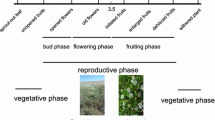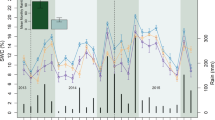Abstract
Socio-economic changes threaten nomadic pastoralism across the world, changing traditional grazing patterns. Such land-use changes will co-occur with climate change, and while both are potentially important determinants of future ecosystem functioning, interactions between them remain poorly understood. We investigated the effects of grazing by large herbivores and climate manipulation using open-top chambers (OTCs) on flower number and flowering species richness in mountain steppe of northern Mongolia. In this region, sedentary pastoralism is replacing nomadic pastoralism, and temperature is predicted to increase. Grazing and OTCs interacted to affect forb flowering richness, which was reduced following grazing removal, and reduced by OTCs in grazed plots only. This interaction was directly linked to the soil moisture and temperature environments created by the experimental treatments: most species flowered when both soil moisture and temperature levels were high (i.e. in grazed plots without OTCs), while fewer species flowered when either temperature, or moisture, or both, were low. Removal of grazing increased the average number of graminoid flowers produced at peak flowering in Year 1, but otherwise grazing removal and OTCs did not affect community-level flower composition. Of four abundant graminoid species examined individually, three showed increased flower number with grazing removal, while one showed the reverse. Four abundant forb species showed no significant response to either treatment. Our results highlight how climate change effects on mountain steppe could be contingent on land-use, and that studies designed to understand ecosystem response to climate change should incorporate co-occurring drivers of change, such as altered grazing regimes.



Similar content being viewed by others
References
Anderson MJ, Willis TJ (2003) Canonical analysis of principal coordinates: a useful method of constrained ordination for ecology. Ecology 84:511–525
Bates D, Maechler M, Bolker B (2012) lme4: Linear mixed-effects models using S4 classes. R package version 0.999999-0
Batima P, Natsagdorj L, Batnasan N (2008) Vulnerability of Mongolia’s pastoralists to climate extremes and changes. In: Leary N, Conde C, Kulkarni J, Nyong A, Pulhin J (eds) Climate change and vulnerability. Earthscan, Sterling, pp 33–87
Clark CJ, Poulsen JR, Levey DJ, Osenberg CW (2007) Are plant populations seed limited? A critique and meta-analysis of seed addition experiments. Am Nat 170:128–142
Deutsch ES, Bork EW, Willms WD (2010) Separation of grassland litter and ecosite influences on seasonal soil moisture and plant growth dynamics. Plant Ecol 209:135–145
Dong S, Wen L, Liu S, Zhang X, Lassoie JP, Yi S, Li X, Li J, Li Y (2011) Vulnerability of worldwide pastoralism to global changes and interdisciplinary strategies for sustainable pastoralism. Ecol Soc 16:10
Dunne JA, Harte J, Taylor KJ (2003) Subalpine meadow flowering phenology responses to climate change: integrating experimental and gradient methods. Ecology 85:904–916
Ellison L (1960) Influence of grazing on plant succession of rangelands. Bot Rev 26:1–78
Elmendorf SC, Henry GHR, Hollister RD, Björk RG, Bjorkman AD, Callaghan TV, Collier LS, Cooper EJ, Cornelissen JHC, Day TA, Fosaa AM, Gould WA, Grétarsdóttir J, Harte J, Hermanutz L, Hik DS, Hofgaard A, Jarrad F, Jónsdóttir IS, Keuper F, Klanderud K, Klein JA, Koh S, Kudo G, Lang SI, Loewen V, May JL, Mercado J, Michelsen A, Molau U, Myers-Smith IH, Oberbauer SF, Pieper S, Post E, Rixen C, Robinson CH, Schmidt NM, Shaver GR, Stenström A, Tolvanen A, Totland Ø, Troxler T, Wahren C, Webber PJ, Welker JM, Wookey PA (2012) Global assessment of experimental climate warming on tundra vegetation: heterogeneity over space and time. Ecol Lett 15:164–175
Facelli JM, Pickett STA (1991) Plant litter: its dynamics and effects on plant community structure. Bot Rev 157:1–32
Fox J, Weisberg S (2011) An R companion to applied regression, 2nd edn. Sage, Thousand Oaks
FAO Animal Production and Health Paper (2001) Pastoralism in the new millennium. 0254-6019, no 150
Grime JP (1973) Competitive exclusion in herbaceous vegetation. Nature 242:244–347
He N, Han X, Yu G, Chen Q (2011) Divergent changes in plant community composition under 3-decade grazing exclusion in continental steppe. PLoS ONE 6:1–8
Hegland SJ, Boeke L (2006) Relationships between the density and diversity of floral resources and flower visitor activity in a temperate grassland community. Ecol Entomol 31:532–538
Hofgaard A, Løkken JO, Dalen L, Hytteborn H (2010) Comparing warming and grazing effects on birch growth in an alpine environment. Plant Ecol Div 3:19–27
Hollister RD, Webber PJ (2000) Biotic validation of small open-top chambers in a tundra ecosystem. Glob Change Biol 6:835–842
Hoover SER, Ladley JJ, Shchepetkina AA, Tisch M, Gieseg SP, Tylianakis JM (2012) Warming, CO2, and nitrogen deposition interactively affect a plant-pollinator mutualism. Ecol Lett 15:227–234
IPCC (2007) Climate change 2007: the physical science basis. Contribution of working group I to the fourth assessment. In: Solomon S, Qin D, Manning M, Chen Z, Marquis M, Averyt KB, Tignor M, Miller HL (eds) Report of the intergovernmental panel on climate change. Cambridge University Press, Cambridge
Jacquemen H, Brys R, Jongejans E (2010) Seed limitation restricts population growth in shaded populations of a perennial woodland orchid. Ecology 91:119–129
Klein JA, Harte J, Zhao X (2004) Experimental warming causes large and rapid species loss, dampened by simulated grazing, on the Tibetan Plateau. Ecol Lett 7:1170–1179
Klein JA, Harte J, Zhao X (2005) Dynamic and complex microclimate responses to warming and grazing manipulations. Glob Change Biol 11:1440–1451
La Pierre KJ, Yuan S, Chang CC, Avolio ML, Hallett LM, Schreck T, Smith MD (2010) Explaining temporal variation in above-ground productivity in a mesic grassland: the role of climate and flowering. J Ecol 99:1250–1262
Laliberté E, Legendre P (2010) A distance-based framework for measuring functional diversity from multiple traits. Ecology 91:299–305
Laliberté E, Shipley B (2011) FD: measuring functional diversity (FD) from multiple traits, and other tools for functional ecology. R package version 1.0-11
Lamb EG (2008) Direct and indirect control of grassland community structure by litter, resources, and biomass. Ecology 89:216–255
Lavorel S, Garnier E (2002) Predicting changes in community composition and ecosystem functioning from plant traits: revisiting the Holy Grail. Funct Ecol 16:545–556
Lawrence MA (2012) ez: easy analysis and visualization of factorial experiments. R package version 4.1-1
Liancourt P, Sharkhuu A, Lkhagva A, Boldgiv B, Helliker BR, Plante AF, Petraitis PS, Casper BB (2012a) Temporal and spatial variation in how vegetation alters the soil moisture response to climate manipulation. Plant Soil 351:249–261
Liancourt P, Spence LA, Lkhagva A, Boldgiv B, Helliker BR, Casper BB, Petraitis PS (2012b) Vulnerability of the northern Mongolian steppe to climate change: insights from flower production and phenology. Ecology 93:815–824
Liancourt P, Spence LA, Song DS, Lkhagva A, Sharkuu A, Boldgiv B, Helliker BR, Petraitis PS, Casper BB (2013) Plant response to climate change varies with topography, interactions with neighbors, and ecotype. Ecology 94:444–453
Llorens L, Peñuelas J (2005) Experimental evidence of future drier and warmer conditions affecting flowering of two co-occurring Mediterranean shrubs. Int J Plant Sci 166:235–245
Maalouf J, Le Bagousse-Pinguet Y, Marchand L, Bâchelier E, Touzard B, Michalet R (2012) Integrating climate change into calcareous grassland management. J Appl Ecol 49:795–802
Marin A (2010) Riders under storms: contribution of nomadic herders’ observations to analysing climate change in Mongolia. Glob Environ Change 20:162–176
Marion GM, Henry GHR, Freckman DW, Johnstone J, Jones G, Jones MH, Lévesque E, Molau U, Mølgaard P, Parsons AN, Svoboda J, Virginia RA (1997) Open-top designs for manipulating field temperature in high-latitude ecosystems. Glob Change Biol 3:20–32
MEA (2005) Millennium ecosystem assessment, ecosystems and human well-being: synthesis. Island Press, Washington
Morris E, Bruun O (2005) Promoting employment opportunities in rural Mongolia: past experience and ILO approaches. International Labour Office, Bangkok
Namgail T, Bhatnagar YV, Mishra C, Bagchi S (2007) Pastoral nomads of the Indian Changthang: production system, landuse and socioeconomic changes. Hum Ecol 35:497–504
Namkhaijantsan G (2006) Climate and climate change of the Hövsgöl region. In: Goulden CE, Sitnikova T, Gelhaus J, Boldgiv B (eds) The geology, biodiversity and ecology of Lake Hövsgöl (Mongolia). Backhuys, Leiden, pp 63–76
Nandintsetseg B, Greene JS, Goulden CE (2007) Trends in extreme daily precipitation and temperature near Lake Hovsgol, Mongolia. Int J Climatol 27:341–347
Oberbauer SF, Tweedie CE, Welker JM, Fahnestock JT, Henry GHR, Webber PJ, Hollister RD, Walker MD, Kuchy A, Elmore E, Starr G (2007) Tundra CO2 fluxes in response to experimental warming across latitudinal and moisture gradients. Ecol Monogr 77:221–238
Oksanen J, Blanchet FG, Kindt R, Legendre P, Minchin PR, O’Hara RB, Simpson GL, Solymos P, Steven HH, Wagner H (2013) vegan: Community Ecology Package. R package version 2.0-9
Olofsson J, Okansen L, Callaghan T, Hulme PE, Okansen T, Suominen O (2009) Herbivores inhibit climate-driven shrub expansion on the tundra. Glob Change Biol 15:2681–2693
Post E (2013) Erosion of community diversity and stability by herbivore removal under warming. Proc R Soc Lond B 280:20122722
Post E, Pedersen C (2008) Opposing plant community responses to warming with and without herbivores. Proc Natl Acad Sci USA 105:12353–12358
Primack RB, Ibáñez I, Higuchi H, Lee SD, Miller-Rushing AJ, Wilson AM, Silander JA Jr (2009) Spatial and interspecific variability in phenological responses to warming temperatures. Biol Conserv 11:2569–2577
Rustad LE (2008) The response of terrestrial ecosystems to global climate change: towards and integrated approach. Sci Total Environ 404:222–235
R Development Core Team (2011) R: a language and environment for statistical computing
Sala OE, Chapin FS III, Armesto JJ, Berlow E, Bloomfield J, Dirzo R, Huber-Sanwald E, Huenneke LF, Jackson RB, Kinzig A, Leemans R, Lodge DM, Mooney HA, Oesterheld M, Poff NL, Sykes MT, Walker BH, Walker M, Wall DH (2000) Global biodiversity scenarios for the year 2100. Science 287:1770–1774
Sato T, Kimura F, Kitoh A (2007) Projection of global warming onto regional precipitation over Mongolia using a regional climate model. J Hydrol 333:144–154
Schwartz CC, Ellis JE (1981) Feeding ecology and niche separation in some native and domestic ungulates in shortgrass prairie. J Appl Ecol 18:343–353
Sokal RR, Rohlf FJ (2012) Biometry, 4th edn. Freeman, New York
Tielbörger K, Fleischer A, Menzel L, Metz J, Sternberg M (2010) The aesthetics of water and land: a promising concept for managing scarce water resources under climate change. Philos Trans R Soc Lond A 368:5323–5337
Walker DA, Raynolds MK, Daniels FJA, Einarsson E, Elvebakk A, Gould WA, Katenin AE, Kholod SS, Markon CJ, Melnikov ES, Moskalenko NG, Talbot SS, Yurtsev BA, Team C (2005) The circumpolar arctic vegetation map. J Veg Sci 16:267–282
Wan S, Luo Y, Wallace L (2002) Changes in microclimate induced by experimental warming and clipping in tallgrass prairie. Glob Change Biol 8:754–768
Wolkovich EM, Cook BI, Allen JM, Crimmins TM, Betancourt JL, Travers SE, Pau S, Regetz J, Davies TJ, Kraft NJB, Ault TR, Bolmgren K, Mazer SJ, McCabe GJ, McGill BJ, Parmesan C, Salamin N, Schwartz MD, Cleland EE (2012) Warming experiments underpredict plant phenological responses to climate change. Nature 485:494–497
Wookey PA (2008) Experimental approaches to predicting the future of tundra plant communities. Plant Ecol Div 1:299–307
Yu F, Price KP, Ellis J, Shi P (2003) Response of seasonal vegetation development to climatic variations in eastern central Asia. Remote Sens Environ 87:42–54
Acknowledgments
We thank S. Undrakhbold, A. Lkhagva, the research camp staff, and the US and Mongolian undergraduates who spent their summer in Dalbay. We are particularly grateful to B. Kemps, J. Stahl, and D. Song for data collection, and J. Mortensen and D. Brickley for their help throughout the duration of the project, and for B. Helliker for comments on the experimental design and the manuscript. Support for this research and the PIRE-Mongolia project was provided by the US National Science Foundation (OISE 0729786). The experiment reported here complies with the current laws of Mongolia.
Author information
Authors and Affiliations
Corresponding author
Additional information
Communicated by Melinda Smith.
Electronic supplementary material
Below is the link to the electronic supplementary material.
Rights and permissions
About this article
Cite this article
Spence, L.A., Liancourt, P., Boldgiv, B. et al. Climate change and grazing interact to alter flowering patterns in the Mongolian steppe. Oecologia 175, 251–260 (2014). https://doi.org/10.1007/s00442-014-2884-z
Received:
Accepted:
Published:
Issue Date:
DOI: https://doi.org/10.1007/s00442-014-2884-z




